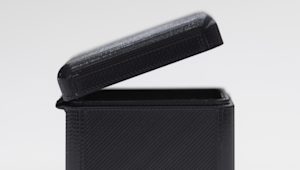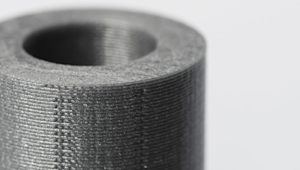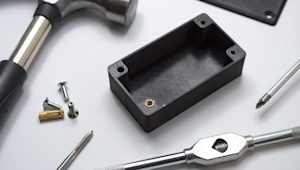3d Printed Snap Fit Design
How to design snap-fit joints for 3D printing
This guide discusses the benefits of 3D printing snap-fits and gives design and material recommendations.
Designing snap-fit connections
In general, snap-fits will encounter the most stress during attachment and should return to their neutral position once the joining process is completed.
Once the parts are mated, an undercut holds them together. Depending on the shape of the undercut, snap-fit assemblies can also be designed to be permanent. A well designed snap-fit with suitable material can be used many times without any noticeable fatigue.
Good design practice
Several design features can be implemented to reduce stress and strain on the snap-fit assembly. These include:

Taper the design
A snap-fit cantilever with constant cross section has an uneven distribution of strain (top image). A good design tip is to diminish the cross section of cantilever beam over its length (bottom image). This uses less material and results in a more even distribution of strain in the cantilever.

Filleting the base of the cantilever
The addition of a fillet at the base of the cantilever can help to distribute the stress over a broader area making the connection stronger. The radius of the fillet should be at least of 0.5x the thickness of the base of the cantilever.

Increase width
Increasing the width of the clip will add strength to the design (if this is feasible in the design constraints). This may require trial and error to achieve the correct stiffness however the clip should be at least 5mm wide.

Final position
To help reduce stress and improve the strength of the connection ensure that the snap-fit cantilever is only deflected during the assembly and not when the components are connected together.

Build direction
It's important to consider build direction. If possible, try to avoid designing snap-fit cantilevers that are built up from the bed vertically (in the z direction) as these are inherently weaker due to the anisotropic nature of 3D printing. A snap fit built in the direction shown in the image to the left will be much stronger.

Add lugs
Consider adding lugs into your assembly to assist with alignment of components and to transfer some of the shear loads that the clips may be subjected to.
Advanced design guides
Advanced design of snap-fit connections is out of the scope of this article. For more detailed information on the design of cantilever snap-fits the MIT snap-fit design guide and snap-fit design for plastics offer excellent technical background and design specifications.
#### Tolerances
Variations in 3D printing properties including printer calibration, print materials and printer technology mean there are no strict tolerancing rules when printing snap-fit connections.
For FDM a tolerance of 0.5 mm is recommended, and a tolerance of 0.3 mm best for all other 3D printing processes.
More resources for engineers

The importance of designing draft angles for injection molding
Learn why draft angles for injection molded parts are a required feature, as well as design considerations and tips in order to design them correctly.
Read article

How to design parts for injection molding
A complete guide to Injection Molding with basic & advanced design tips, including design guidelines for snap-fits, living hinges, undercuts and surface finishes.
Read article

How to design parts for binder jetting 3D printing
A comprehensive guide on designing parts for Binder Jetting, covering the printing process, design specifications and material options.
Read article

How to design parts for material jetting 3D printing
This article explains how to design Material Jetting 3D printed parts including technical design specifications, materials, limitations and an introduction into the post-processing options available.
Read article

How to design parts for metal 3D printing
A comprehensive guide for metal 3D printing covering the printing process, design specifications, material options and technology limitations.
Read article

How to design living hinges for 3D printing
This article discusses the advantages of living hinges and present-day design rules and material recommendations when using 3D printing to produce living hinges.
Read article

How to design parts for SLS 3D printing
This article discusses how to design SLS 3D printed parts including technical design specifications, materials, limitations and an introduction into the post-processing options available.
Read article

Selecting the optimal shell and infill parameters for FDM 3D printing
Shell and infill properties impact the performance and cost of FDM 3D printing. Learn how to optimize these features for your 3D printed part
Read article

How does part orientation affect a 3D print?
This article discusses the impact part orientation has on the accuracy, strength, speed and surface finish of 3D printed parts.
Read article

The impact of layer height on a 3D print
Learn about the importance of layer height and how it affects the quality, appearance and strength of 3D printed parts
Read article

3D printing geometry restrictions
Learn about how large a 3D print can be along with how element thickness, watertightness, and curved surfaces affect the quality of a print.
Read article

How to assemble 3D printed parts with threaded fasteners
Compare different methods for creating threads in your parts and follow step-by-step instructions on how to install your fasteners.
Read article

The importance of designing draft angles for injection molding
Learn why draft angles for injection molded parts are a required feature, as well as design considerations and tips in order to design them correctly.
Read article

How to design parts for injection molding
A complete guide to Injection Molding with basic & advanced design tips, including design guidelines for snap-fits, living hinges, undercuts and surface finishes.
Read article

How to design parts for binder jetting 3D printing
A comprehensive guide on designing parts for Binder Jetting, covering the printing process, design specifications and material options.
Read article

How to design parts for material jetting 3D printing
This article explains how to design Material Jetting 3D printed parts including technical design specifications, materials, limitations and an introduction into the post-processing options available.
Read article

How to design parts for metal 3D printing
A comprehensive guide for metal 3D printing covering the printing process, design specifications, material options and technology limitations.
Read article

How to design living hinges for 3D printing
This article discusses the advantages of living hinges and present-day design rules and material recommendations when using 3D printing to produce living hinges.
Read article

How to design parts for SLS 3D printing
This article discusses how to design SLS 3D printed parts including technical design specifications, materials, limitations and an introduction into the post-processing options available.
Read article

Selecting the optimal shell and infill parameters for FDM 3D printing
Shell and infill properties impact the performance and cost of FDM 3D printing. Learn how to optimize these features for your 3D printed part
Read article

How does part orientation affect a 3D print?
This article discusses the impact part orientation has on the accuracy, strength, speed and surface finish of 3D printed parts.
Read article

The impact of layer height on a 3D print
Learn about the importance of layer height and how it affects the quality, appearance and strength of 3D printed parts
Read article

3D printing geometry restrictions
Learn about how large a 3D print can be along with how element thickness, watertightness, and curved surfaces affect the quality of a print.
Read article

How to assemble 3D printed parts with threaded fasteners
Compare different methods for creating threads in your parts and follow step-by-step instructions on how to install your fasteners.
Read article
3d Printed Snap Fit Design
Source: https://www.hubs.com/knowledge-base/how-design-snap-fit-joints-3d-printing/
Posted by: lowewincert.blogspot.com

0 Response to "3d Printed Snap Fit Design"
Post a Comment